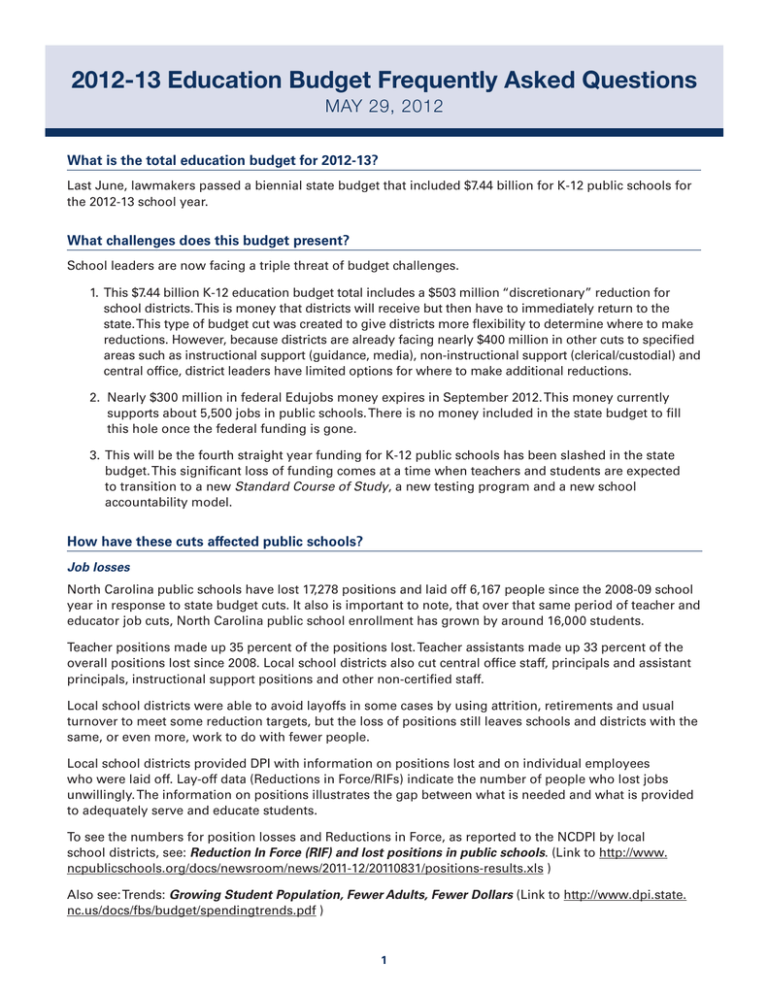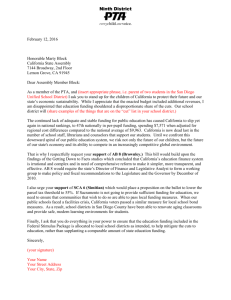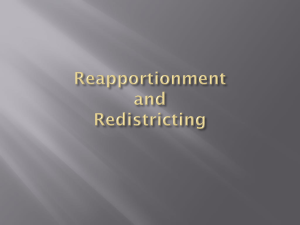2012-13 Education Budget Frequently Asked Questions May 29, 2012
advertisement

2012-13 Education Budget Frequently Asked Questions May 29, 2012 What is the total education budget for 2012-13? Last June, lawmakers passed a biennial state budget that included $7.44 billion for K-12 public schools for the 2012-13 school year. What challenges does this budget present? School leaders are now facing a triple threat of budget challenges. 1. T his $7.44 billion K-12 education budget total includes a $503 million “discretionary” reduction for school districts. This is money that districts will receive but then have to immediately return to the state. This type of budget cut was created to give districts more flexibility to determine where to make reductions. However, because districts are already facing nearly $400 million in other cuts to specified areas such as instructional support (guidance, media), non-instructional support (clerical/custodial) and central office, district leaders have limited options for where to make additional reductions. 2. N early $300 million in federal Edujobs money expires in September 2012. This money currently supports about 5,500 jobs in public schools. There is no money included in the state budget to fill this hole once the federal funding is gone. 3. T his will be the fourth straight year funding for K-12 public schools has been slashed in the state budget. This significant loss of funding comes at a time when teachers and students are expected to transition to a new Standard Course of Study, a new testing program and a new school accountability model. How have these cuts affected public schools? Job losses North Carolina public schools have lost 17,278 positions and laid off 6,167 people since the 2008-09 school year in response to state budget cuts. It also is important to note, that over that same period of teacher and educator job cuts, North Carolina public school enrollment has grown by around 16,000 students. Teacher positions made up 35 percent of the positions lost. Teacher assistants made up 33 percent of the overall positions lost since 2008. Local school districts also cut central office staff, principals and assistant principals, instructional support positions and other non-certified staff. Local school districts were able to avoid layoffs in some cases by using attrition, retirements and usual turnover to meet some reduction targets, but the loss of positions still leaves schools and districts with the same, or even more, work to do with fewer people. Local school districts provided DPI with information on positions lost and on individual employees who were laid off. Lay-off data (Reductions in Force/RIFs) indicate the number of people who lost jobs unwillingly. The information on positions illustrates the gap between what is needed and what is provided to adequately serve and educate students. To see the numbers for position losses and Reductions in Force, as reported to the NCDPI by local school districts, see: Reduction In Force (RIF) and lost positions in public schools. (Link to http://www. ncpublicschools.org/docs/newsroom/news/2011-12/20110831/positions-results.xls ) Also see: Trends: Growing Student Population, Fewer Adults, Fewer Dollars (Link to http://www.dpi.state. nc.us/docs/fbs/budget/spendingtrends.pdf ) 1 What about claims that the number of full-time positions in public schools have increased? In 2010, the General Assembly removed $398 million from the state’s Public School Fund and replaced this funding with federal stabilization funds. In August 2010, 9,282 jobs were funded with the federal stabilization dollars. The stabilization funds were exhausted in 2011-12 and the General Assembly reinstated 80 percent of the previously reduced state funds, but also increased the discretionary reduction (negative reserve where a district has to return a portion of their allotments to be within budget). Therefore, the 2011-12 the budget shows an increase in state-funded positions as districts move personnel from federal to state funds; however, in reality, the total number of people working in North Carolina public schools has declined significantly. To read more about types of federal funds that have been available to public schools over the past few years, visit: • North Carolina and the American Recovery and Reinvestment Act (ARRA) of 2009 http://www. dpi.state.nc.us/fbs/arra/ • Public Schools of North Carolina American Recovery and Reinvestment Act (ARRA) Expenditures http://apps.schools.nc.gov/pls/apex/f?p=122:1:1532607769071346 Interesting Question: How many teachers could a school district buy with $1 million? Answer: 21 Class Sizes Local school superintendents from across the state also have reported that class sizes have increased significantly as a result of state budget cuts. Some teachers have reported having 33 or more students in one class. Many have asked how class sizes could be this large since lawmakers and others often refer to teacher-to-student ratios that are 1:17 or 1:18 in grades K-3 and 1:21 or 1:22 in middle school. These are Teacher Allotment Ratios and they represent the funding formula the state uses to give local school districts enough money to hire enough teachers based on each district’s student population. Yet, because students don’t come in perfect groups of 18 and because ALL teachers (including teachers for art, music, P.E. and other special classes outside of the core curriculum) are funded by this formula, teacher-to-student ratios in the early grades often are much larger than 1:18. In addition, by law, class sizes in grades K-3 should not exceed 24 students, but over the past few years lawmakers have waived all class size requirements in grades 4-12 as a way to help districts deal with state budget cuts. What other problems have school districts reported? Districts have reported that they have fewer teachers, teacher assistants and assistant principals to help supervise students and maintain student discipline. Course selection at the high school level has decreased. Some schools have nurses only one or two days a week and teachers are being trained to administer student medication. There are fewer custodians to clean the buildings. Students are sharing textbooks and other equipment. School building repair has been placed on hold. Students wake up earlier and get home later due to longer bus routes. Local district officials agree that they do not have the resources to meet the needs of students or teachers. 2 What programs were completely eliminated as a part of the 2011-13 biennial budget? Funding was eliminated for teacher mentors, staff development, dropout prevention, student diagnostics and school technology. State funding also was eliminated for the Governor’s School, which was created in 1963. The Teaching Fellows program is currently scheduled to be phased out after the 2011-12 class. What has been the impact on teacher pay? The national average teacher salary for Southeast Region 2010-11 was $55,623 while North Carolina’s average was $46,700. The state was ranked 7th among 12 states in the Southeast for average teacher compensation. A May 2011 Huffington Post article also named North Carolina among the top 10 states in the country in which teachers are paid the worst. North Carolina teachers have not received raises or ABCs bonuses for the past four years. What is the dollar amount we spend per pupil and where does NC rank among other states? A variety of per-pupil spending rankings that have been completed by the National Education Association, Ed Week and the Annie E. Casey Foundation and often are based on financial data from earlier school years and rank North Carolina among the bottom 10 states in the nation for per-pupil spending. These types of rankings often incorporate various adjustments and must factor in other variables for differences among states such as cost of living, etc, and that is why most of the data these rankings depend on data that are at least one or two years old. Therefore, these national rankings do not reflect recent budget cuts and its impact on North Carolina’s per-pupil spending rates. It is accurate to say that North Carolina has consistently ranked near the bottom of the nation for the amount of dollars spent per public school student and recent budget cuts have not done anything to improve the state’s standing in this area. What about the lottery? The North Carolina Education Lottery provides an important revenue stream ($419 million in 2010-11) for education. Yet this dollar amount represents only about 30 percent of the total operating revenue for the lottery. Of the portion of the lottery that is directed to education, NCDPI allocates the money according to the following percentages to meet very specific needs: • 52% - teacher salaries for class size reductions in grades K-3 • 15 % - prekindergarten programs for at-risk 4-year-olds • 24% - school construction • 9 % - need-based scholarships and financial aid for students in North Carolina public and private universities and community colleges Yet, if you consider these allocations as they relate to the total lottery funds, the percentages are: • 16% - teacher salaries for class size reductions in grades K-3 • 5% - prekindergarten programs for at-risk 4-year-olds • 7% - school construction • 3% - need-based scholarships and financial aid for students in North Carolina public and private universities and community colleges To see how much each local district receives in lottery funding, see the NC Education Lottery 2011 Beneficiary Brochure (http://www.nc-educationlottery.org/uploads/docs/Beneficiary_Brochure_fy2011.pdf) 3 Interesting Fact: The total operating revenue for the NC Education Lottery in 2010-11 was $1,464,640,000. Currently, about 30 percent of that revenue goes to education. Yet, even if the NC Education Lottery gave ALL of its revenue to schools, it would only cover about 19 percent of the state’s total budget for K-12 public schools. What happens next? The State Board of Education has presented its requests for budget adjustments for the 2012-13 year to the Office of State Budget and Management. The Governor also has presented her recommended budget adjustments to the General Assembly. The Senate and the House are now developing and discussing their versions of the budget. They will then present their version of the budget to the Governor. A final budget for 2012-13 must be approved by July 1. What can you do? Now is the time to analyze and communicate the needs of schools and educators to legislators. • Visit www.ncleg.net for phone numbers and email addresses for state senators and representatives. Use this information to stay in contact with your legislators regarding how the budget cuts have and will affect class size, course offerings, safety, and other issues for your community’s schools. • Inform your community including parents and students as to what the changes will mean for your schools and students. • Share the information in this document, and other budget information available at http://www.ncpublicschools.org/budget/ in newsletters, e-mails and other communications. Your help is critical in spreading the message that we need to invest in the future and fund schools first. 4



